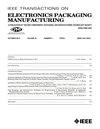Flexible Electronics: Thin Silicon Die on Flexible Substrates
IEEE Transactions on Electronics Packaging Manufacturing
Pub Date : 2009-08-28
DOI:10.1109/TEPM.2009.2028880
引用次数: 34
Abstract
Silicon thinned to 50 mum and less is flexible allowing the fabrication of flexible and conformable electronics. Two techniques have been developed to achieve this goal using thinned die: die flip chip bonded onto flexible substrates [polyimide and liquid crystal polymer (LCP)] and die flip chip laminated onto LCP films. A key to achieving each of these techniques is the thinning of die to a thickness of 50 mum or thinner. Conventional grinding and polishing can be used to thin to 50 mum. At 50 mum, the active die becomes flexible and must be handled by temporarily bonding it to a holder die for assembly. Both reflow solder and thermocompression assembly methods are used. In the case of solder assembly, underfill is used to reinforce the solder joints. With thermocompression bonding of the die to an LCP substrate, the LCP adheres to the die surface, eliminating the need for underfill.柔性电子:柔性基板上的薄硅模
硅薄至50微米或更小是灵活的,允许制造灵活和符合电子产品。为了实现这一目标,已经开发了两种技术:将倒装芯片粘接在柔性衬底上[聚酰亚胺和液晶聚合物(LCP)],以及将倒装芯片层压在LCP薄膜上。实现这些技术的关键是将模具厚度减薄到50毫米或更薄。常规研磨抛光可达到50 μ m。在50妈妈,主动模具变得灵活,必须处理暂时粘合到一个持有人模具组装。回流焊和热压缩组装方法都被使用。在焊料装配的情况下,下填料用于加强焊点。由于模具与LCP基板的热压粘合,LCP粘附在模具表面,从而消除了下填充的需要。
本文章由计算机程序翻译,如有差异,请以英文原文为准。
求助全文
约1分钟内获得全文
求助全文

 求助内容:
求助内容: 应助结果提醒方式:
应助结果提醒方式:


